K plc: Investment Appraisal, Funding Alternatives & Variance Analysis
VerifiedAdded on 2023/06/14
|15
|3868
|231
Report
AI Summary
This business report provides a comprehensive analysis of K plc's financial decisions. It evaluates various investment projects using payback period and net present value (NPV) methods, ranking them to identify the most viable options. The report also explores alternative funding methods for acquiring shares in an unlisted company, including bank loans, angel investors, and government grants. Furthermore, a detailed variance analysis of variable cost elements is presented, offering possible explanations for identified variances. Finally, the report distinguishes between centralized and decentralized procurement, discussing the benefits of each approach. The analysis aims to provide K plc's directors with a holistic view of financial and operational considerations for informed decision-making. Desklib offers similar solved assignments and past papers for students.
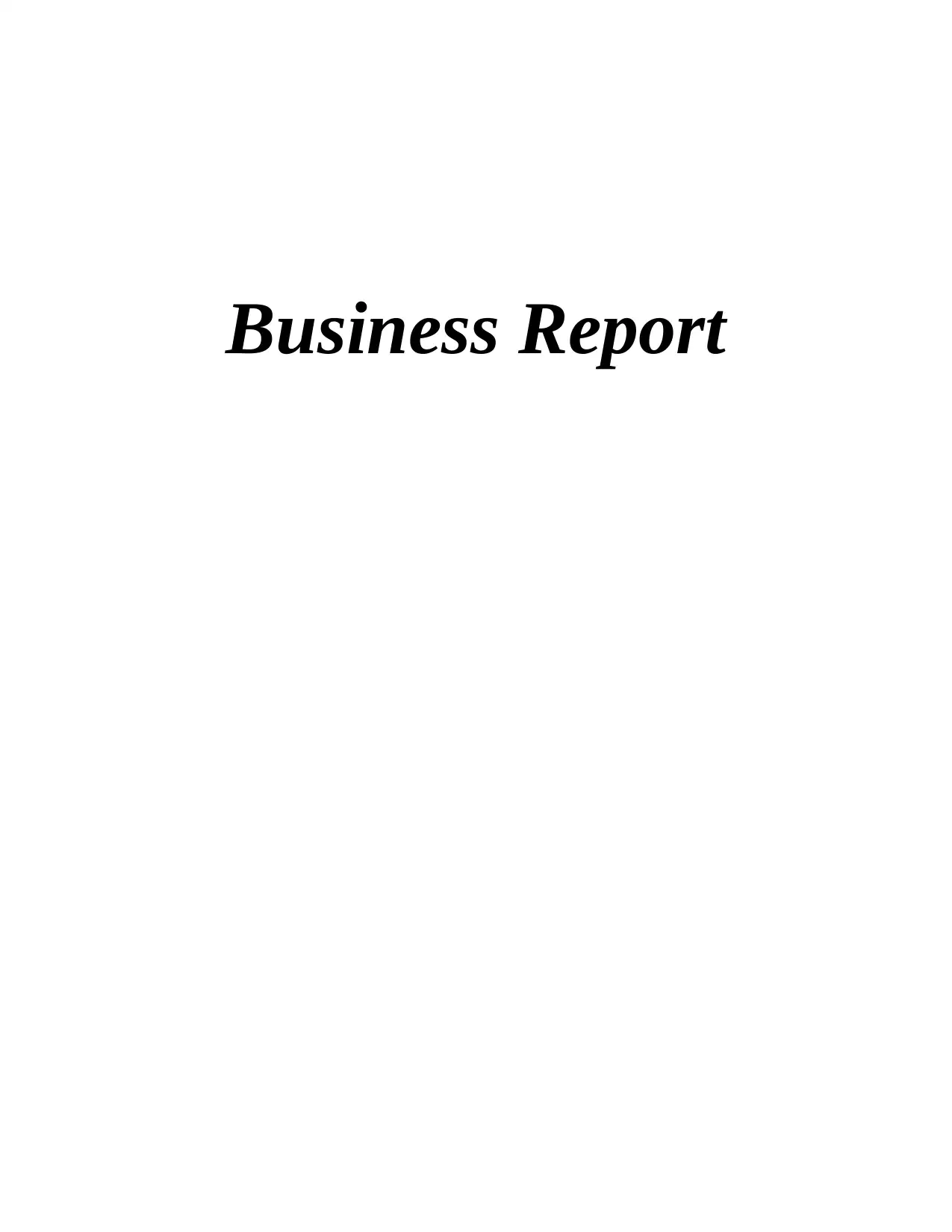
Business Report
Paraphrase This Document
Need a fresh take? Get an instant paraphrase of this document with our AI Paraphraser
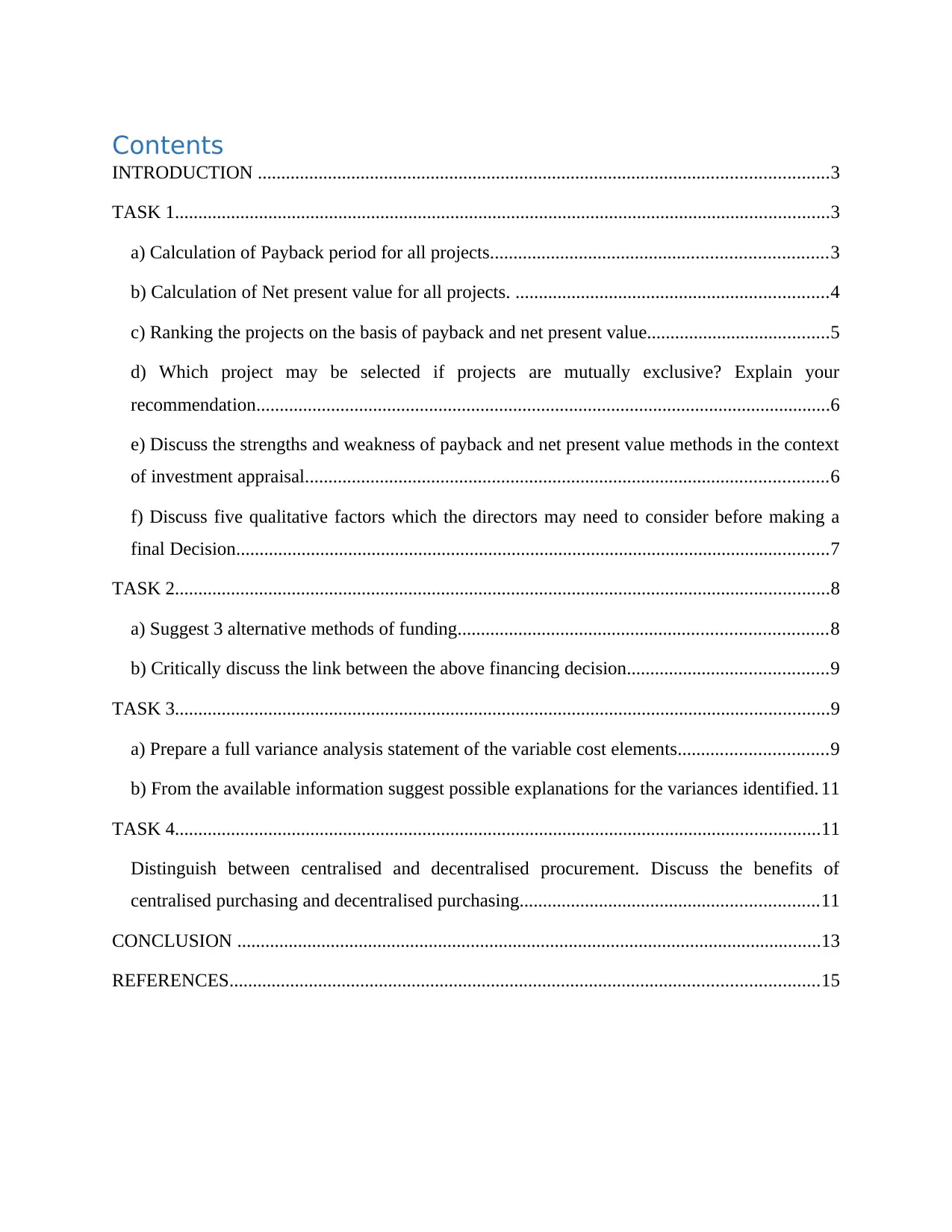
Contents
INTRODUCTION ..........................................................................................................................3
TASK 1............................................................................................................................................3
a) Calculation of Payback period for all projects........................................................................3
b) Calculation of Net present value for all projects. ...................................................................4
c) Ranking the projects on the basis of payback and net present value.......................................5
d) Which project may be selected if projects are mutually exclusive? Explain your
recommendation...........................................................................................................................6
e) Discuss the strengths and weakness of payback and net present value methods in the context
of investment appraisal................................................................................................................6
f) Discuss five qualitative factors which the directors may need to consider before making a
final Decision...............................................................................................................................7
TASK 2............................................................................................................................................8
a) Suggest 3 alternative methods of funding...............................................................................8
b) Critically discuss the link between the above financing decision...........................................9
TASK 3............................................................................................................................................9
a) Prepare a full variance analysis statement of the variable cost elements................................9
b) From the available information suggest possible explanations for the variances identified. 11
TASK 4..........................................................................................................................................11
Distinguish between centralised and decentralised procurement. Discuss the benefits of
centralised purchasing and decentralised purchasing................................................................11
CONCLUSION .............................................................................................................................13
REFERENCES..............................................................................................................................15
INTRODUCTION ..........................................................................................................................3
TASK 1............................................................................................................................................3
a) Calculation of Payback period for all projects........................................................................3
b) Calculation of Net present value for all projects. ...................................................................4
c) Ranking the projects on the basis of payback and net present value.......................................5
d) Which project may be selected if projects are mutually exclusive? Explain your
recommendation...........................................................................................................................6
e) Discuss the strengths and weakness of payback and net present value methods in the context
of investment appraisal................................................................................................................6
f) Discuss five qualitative factors which the directors may need to consider before making a
final Decision...............................................................................................................................7
TASK 2............................................................................................................................................8
a) Suggest 3 alternative methods of funding...............................................................................8
b) Critically discuss the link between the above financing decision...........................................9
TASK 3............................................................................................................................................9
a) Prepare a full variance analysis statement of the variable cost elements................................9
b) From the available information suggest possible explanations for the variances identified. 11
TASK 4..........................................................................................................................................11
Distinguish between centralised and decentralised procurement. Discuss the benefits of
centralised purchasing and decentralised purchasing................................................................11
CONCLUSION .............................................................................................................................13
REFERENCES..............................................................................................................................15
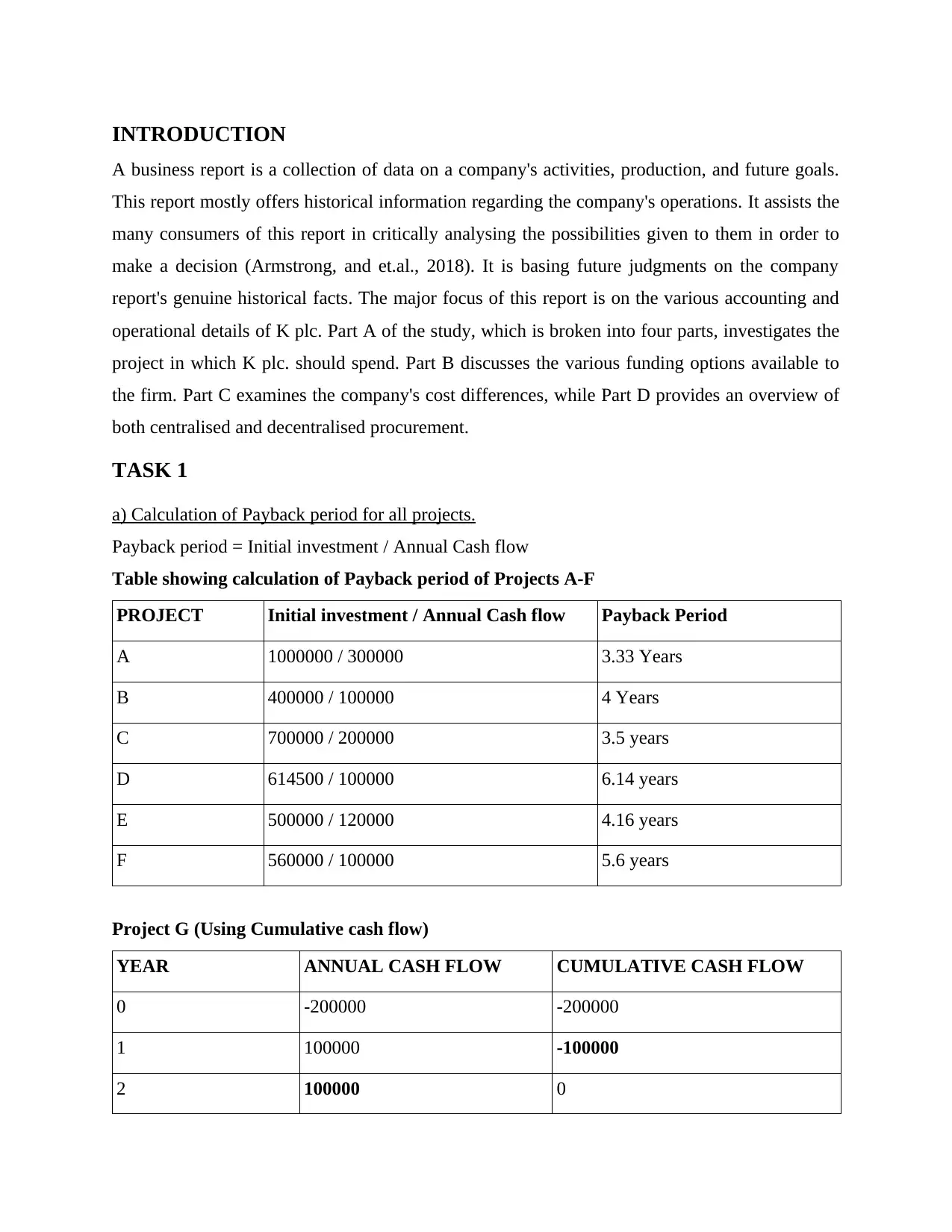
INTRODUCTION
A business report is a collection of data on a company's activities, production, and future goals.
This report mostly offers historical information regarding the company's operations. It assists the
many consumers of this report in critically analysing the possibilities given to them in order to
make a decision (Armstrong, and et.al., 2018). It is basing future judgments on the company
report's genuine historical facts. The major focus of this report is on the various accounting and
operational details of K plc. Part A of the study, which is broken into four parts, investigates the
project in which K plc. should spend. Part B discusses the various funding options available to
the firm. Part C examines the company's cost differences, while Part D provides an overview of
both centralised and decentralised procurement.
TASK 1
a) Calculation of Payback period for all projects.
Payback period = Initial investment / Annual Cash flow
Table showing calculation of Payback period of Projects A-F
PROJECT Initial investment / Annual Cash flow Payback Period
A 1000000 / 300000 3.33 Years
B 400000 / 100000 4 Years
C 700000 / 200000 3.5 years
D 614500 / 100000 6.14 years
E 500000 / 120000 4.16 years
F 560000 / 100000 5.6 years
Project G (Using Cumulative cash flow)
YEAR ANNUAL CASH FLOW CUMULATIVE CASH FLOW
0 -200000 -200000
1 100000 -100000
2 100000 0
A business report is a collection of data on a company's activities, production, and future goals.
This report mostly offers historical information regarding the company's operations. It assists the
many consumers of this report in critically analysing the possibilities given to them in order to
make a decision (Armstrong, and et.al., 2018). It is basing future judgments on the company
report's genuine historical facts. The major focus of this report is on the various accounting and
operational details of K plc. Part A of the study, which is broken into four parts, investigates the
project in which K plc. should spend. Part B discusses the various funding options available to
the firm. Part C examines the company's cost differences, while Part D provides an overview of
both centralised and decentralised procurement.
TASK 1
a) Calculation of Payback period for all projects.
Payback period = Initial investment / Annual Cash flow
Table showing calculation of Payback period of Projects A-F
PROJECT Initial investment / Annual Cash flow Payback Period
A 1000000 / 300000 3.33 Years
B 400000 / 100000 4 Years
C 700000 / 200000 3.5 years
D 614500 / 100000 6.14 years
E 500000 / 120000 4.16 years
F 560000 / 100000 5.6 years
Project G (Using Cumulative cash flow)
YEAR ANNUAL CASH FLOW CUMULATIVE CASH FLOW
0 -200000 -200000
1 100000 -100000
2 100000 0
⊘ This is a preview!⊘
Do you want full access?
Subscribe today to unlock all pages.

Trusted by 1+ million students worldwide
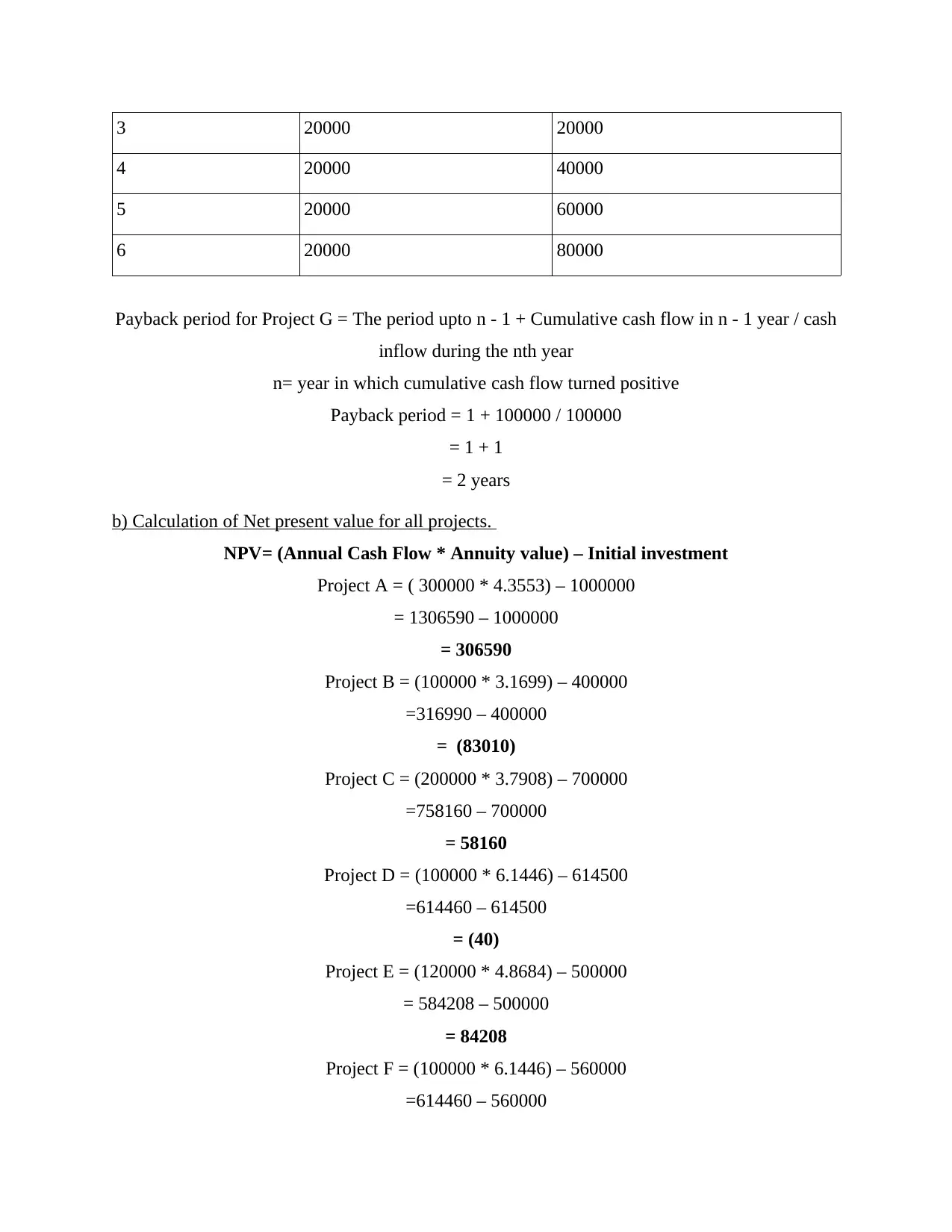
3 20000 20000
4 20000 40000
5 20000 60000
6 20000 80000
Payback period for Project G = The period upto n - 1 + Cumulative cash flow in n - 1 year / cash
inflow during the nth year
n= year in which cumulative cash flow turned positive
Payback period = 1 + 100000 / 100000
= 1 + 1
= 2 years
b) Calculation of Net present value for all projects.
NPV= (Annual Cash Flow * Annuity value) – Initial investment
Project A = ( 300000 * 4.3553) – 1000000
= 1306590 – 1000000
= 306590
Project B = (100000 * 3.1699) – 400000
=316990 – 400000
= (83010)
Project C = (200000 * 3.7908) – 700000
=758160 – 700000
= 58160
Project D = (100000 * 6.1446) – 614500
=614460 – 614500
= (40)
Project E = (120000 * 4.8684) – 500000
= 584208 – 500000
= 84208
Project F = (100000 * 6.1446) – 560000
=614460 – 560000
4 20000 40000
5 20000 60000
6 20000 80000
Payback period for Project G = The period upto n - 1 + Cumulative cash flow in n - 1 year / cash
inflow during the nth year
n= year in which cumulative cash flow turned positive
Payback period = 1 + 100000 / 100000
= 1 + 1
= 2 years
b) Calculation of Net present value for all projects.
NPV= (Annual Cash Flow * Annuity value) – Initial investment
Project A = ( 300000 * 4.3553) – 1000000
= 1306590 – 1000000
= 306590
Project B = (100000 * 3.1699) – 400000
=316990 – 400000
= (83010)
Project C = (200000 * 3.7908) – 700000
=758160 – 700000
= 58160
Project D = (100000 * 6.1446) – 614500
=614460 – 614500
= (40)
Project E = (120000 * 4.8684) – 500000
= 584208 – 500000
= 84208
Project F = (100000 * 6.1446) – 560000
=614460 – 560000
Paraphrase This Document
Need a fresh take? Get an instant paraphrase of this document with our AI Paraphraser
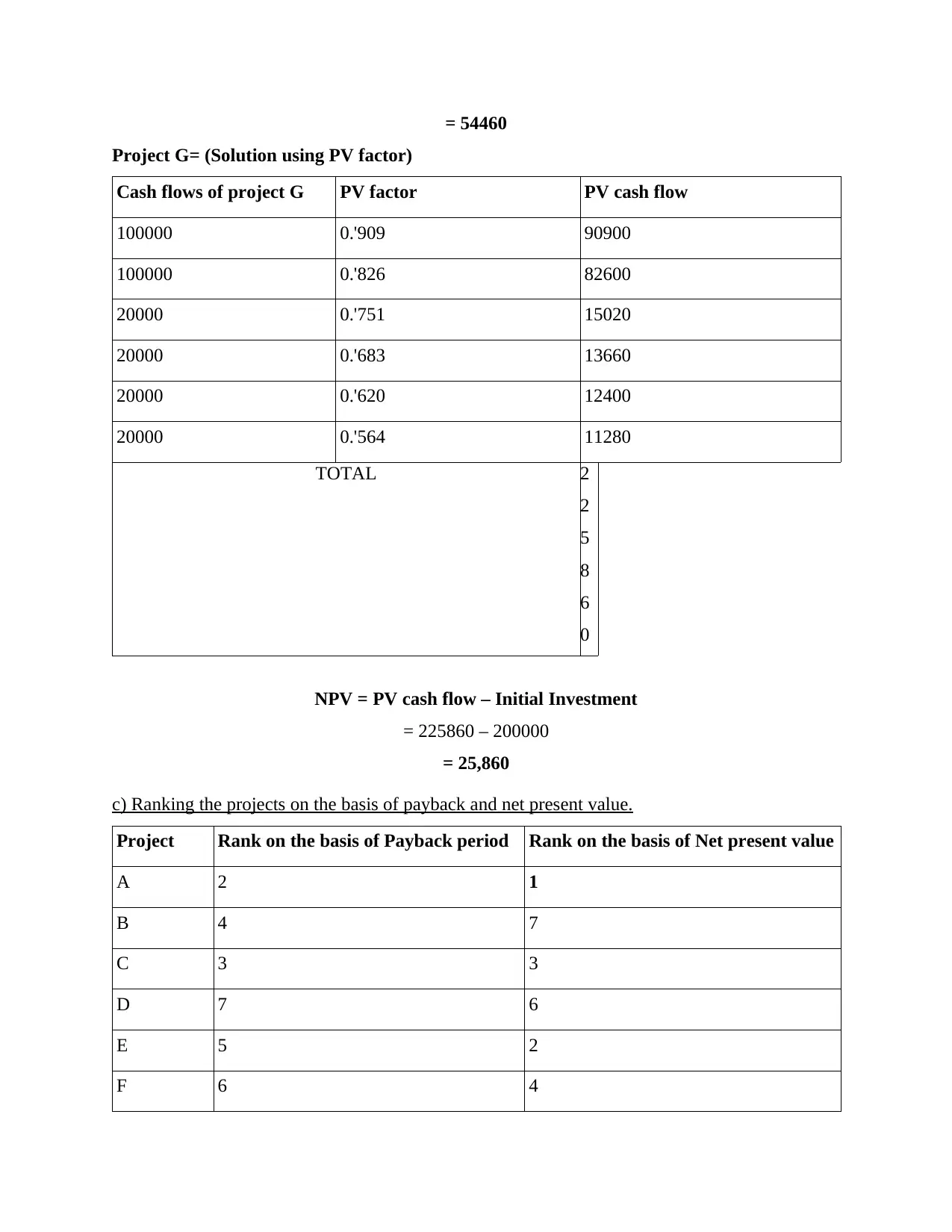
= 54460
Project G= (Solution using PV factor)
Cash flows of project G PV factor PV cash flow
100000 0.'909 90900
100000 0.'826 82600
20000 0.'751 15020
20000 0.'683 13660
20000 0.'620 12400
20000 0.'564 11280
TOTAL 2
2
5
8
6
0
NPV = PV cash flow – Initial Investment
= 225860 – 200000
= 25,860
c) Ranking the projects on the basis of payback and net present value.
Project Rank on the basis of Payback period Rank on the basis of Net present value
A 2 1
B 4 7
C 3 3
D 7 6
E 5 2
F 6 4
Project G= (Solution using PV factor)
Cash flows of project G PV factor PV cash flow
100000 0.'909 90900
100000 0.'826 82600
20000 0.'751 15020
20000 0.'683 13660
20000 0.'620 12400
20000 0.'564 11280
TOTAL 2
2
5
8
6
0
NPV = PV cash flow – Initial Investment
= 225860 – 200000
= 25,860
c) Ranking the projects on the basis of payback and net present value.
Project Rank on the basis of Payback period Rank on the basis of Net present value
A 2 1
B 4 7
C 3 3
D 7 6
E 5 2
F 6 4
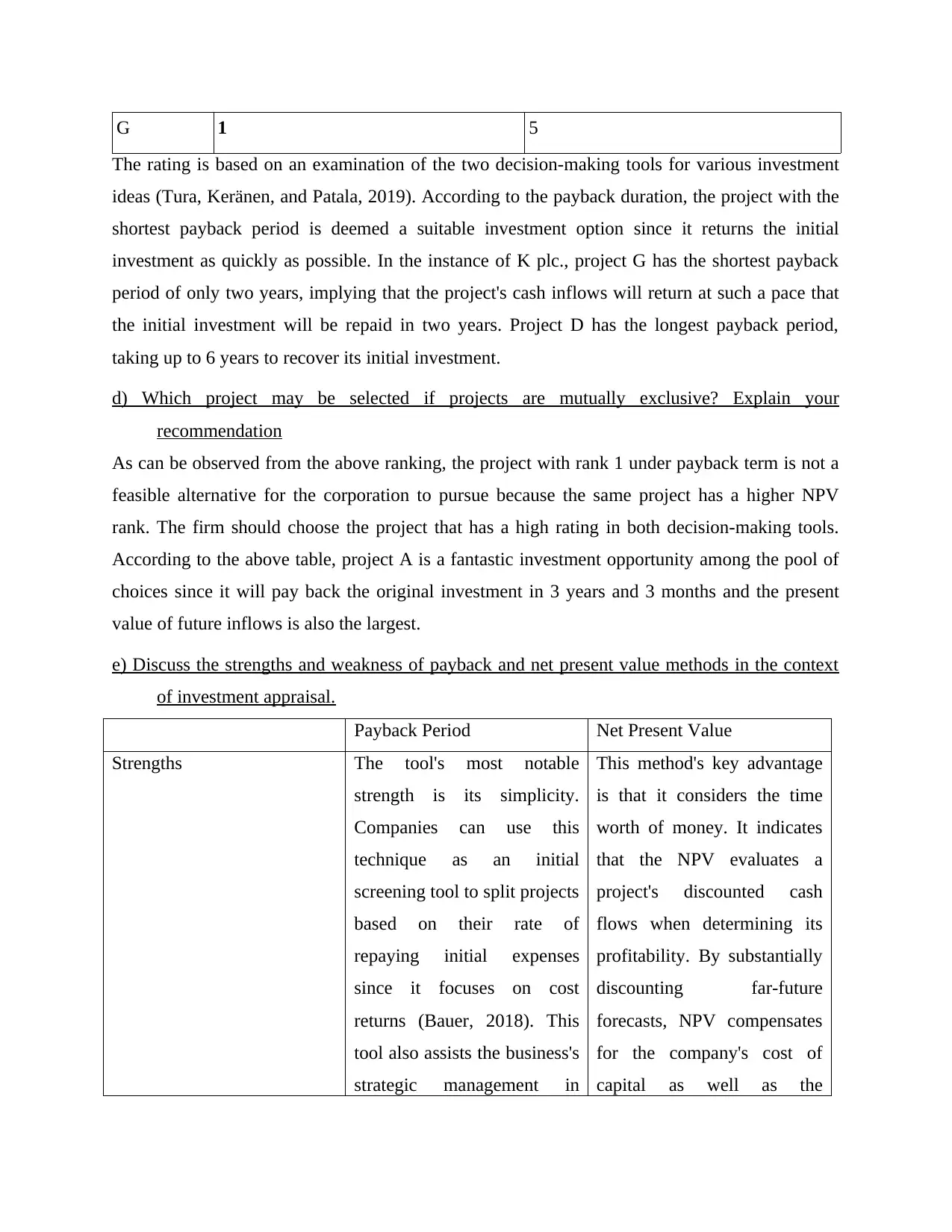
G 1 5
The rating is based on an examination of the two decision-making tools for various investment
ideas (Tura, Keränen, and Patala, 2019). According to the payback duration, the project with the
shortest payback period is deemed a suitable investment option since it returns the initial
investment as quickly as possible. In the instance of K plc., project G has the shortest payback
period of only two years, implying that the project's cash inflows will return at such a pace that
the initial investment will be repaid in two years. Project D has the longest payback period,
taking up to 6 years to recover its initial investment.
d) Which project may be selected if projects are mutually exclusive? Explain your
recommendation
As can be observed from the above ranking, the project with rank 1 under payback term is not a
feasible alternative for the corporation to pursue because the same project has a higher NPV
rank. The firm should choose the project that has a high rating in both decision-making tools.
According to the above table, project A is a fantastic investment opportunity among the pool of
choices since it will pay back the original investment in 3 years and 3 months and the present
value of future inflows is also the largest.
e) Discuss the strengths and weakness of payback and net present value methods in the context
of investment appraisal.
Payback Period Net Present Value
Strengths The tool's most notable
strength is its simplicity.
Companies can use this
technique as an initial
screening tool to split projects
based on their rate of
repaying initial expenses
since it focuses on cost
returns (Bauer, 2018). This
tool also assists the business's
strategic management in
This method's key advantage
is that it considers the time
worth of money. It indicates
that the NPV evaluates a
project's discounted cash
flows when determining its
profitability. By substantially
discounting far-future
forecasts, NPV compensates
for the company's cost of
capital as well as the
The rating is based on an examination of the two decision-making tools for various investment
ideas (Tura, Keränen, and Patala, 2019). According to the payback duration, the project with the
shortest payback period is deemed a suitable investment option since it returns the initial
investment as quickly as possible. In the instance of K plc., project G has the shortest payback
period of only two years, implying that the project's cash inflows will return at such a pace that
the initial investment will be repaid in two years. Project D has the longest payback period,
taking up to 6 years to recover its initial investment.
d) Which project may be selected if projects are mutually exclusive? Explain your
recommendation
As can be observed from the above ranking, the project with rank 1 under payback term is not a
feasible alternative for the corporation to pursue because the same project has a higher NPV
rank. The firm should choose the project that has a high rating in both decision-making tools.
According to the above table, project A is a fantastic investment opportunity among the pool of
choices since it will pay back the original investment in 3 years and 3 months and the present
value of future inflows is also the largest.
e) Discuss the strengths and weakness of payback and net present value methods in the context
of investment appraisal.
Payback Period Net Present Value
Strengths The tool's most notable
strength is its simplicity.
Companies can use this
technique as an initial
screening tool to split projects
based on their rate of
repaying initial expenses
since it focuses on cost
returns (Bauer, 2018). This
tool also assists the business's
strategic management in
This method's key advantage
is that it considers the time
worth of money. It indicates
that the NPV evaluates a
project's discounted cash
flows when determining its
profitability. By substantially
discounting far-future
forecasts, NPV compensates
for the company's cost of
capital as well as the
⊘ This is a preview!⊘
Do you want full access?
Subscribe today to unlock all pages.

Trusted by 1+ million students worldwide
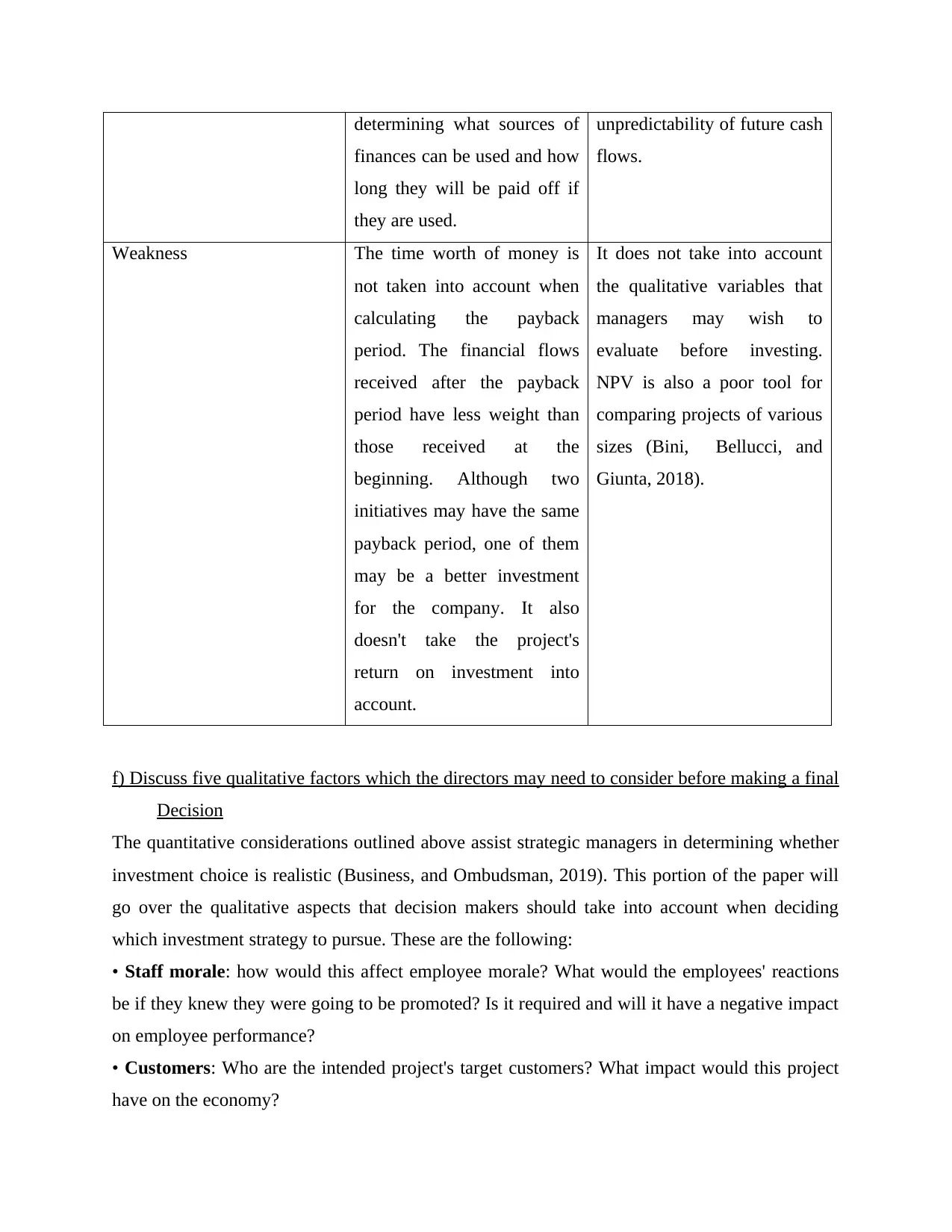
determining what sources of
finances can be used and how
long they will be paid off if
they are used.
unpredictability of future cash
flows.
Weakness The time worth of money is
not taken into account when
calculating the payback
period. The financial flows
received after the payback
period have less weight than
those received at the
beginning. Although two
initiatives may have the same
payback period, one of them
may be a better investment
for the company. It also
doesn't take the project's
return on investment into
account.
It does not take into account
the qualitative variables that
managers may wish to
evaluate before investing.
NPV is also a poor tool for
comparing projects of various
sizes (Bini, Bellucci, and
Giunta, 2018).
f) Discuss five qualitative factors which the directors may need to consider before making a final
Decision
The quantitative considerations outlined above assist strategic managers in determining whether
investment choice is realistic (Business, and Ombudsman, 2019). This portion of the paper will
go over the qualitative aspects that decision makers should take into account when deciding
which investment strategy to pursue. These are the following:
• Staff morale: how would this affect employee morale? What would the employees' reactions
be if they knew they were going to be promoted? Is it required and will it have a negative impact
on employee performance?
• Customers: Who are the intended project's target customers? What impact would this project
have on the economy?
finances can be used and how
long they will be paid off if
they are used.
unpredictability of future cash
flows.
Weakness The time worth of money is
not taken into account when
calculating the payback
period. The financial flows
received after the payback
period have less weight than
those received at the
beginning. Although two
initiatives may have the same
payback period, one of them
may be a better investment
for the company. It also
doesn't take the project's
return on investment into
account.
It does not take into account
the qualitative variables that
managers may wish to
evaluate before investing.
NPV is also a poor tool for
comparing projects of various
sizes (Bini, Bellucci, and
Giunta, 2018).
f) Discuss five qualitative factors which the directors may need to consider before making a final
Decision
The quantitative considerations outlined above assist strategic managers in determining whether
investment choice is realistic (Business, and Ombudsman, 2019). This portion of the paper will
go over the qualitative aspects that decision makers should take into account when deciding
which investment strategy to pursue. These are the following:
• Staff morale: how would this affect employee morale? What would the employees' reactions
be if they knew they were going to be promoted? Is it required and will it have a negative impact
on employee performance?
• Customers: Who are the intended project's target customers? What impact would this project
have on the economy?
Paraphrase This Document
Need a fresh take? Get an instant paraphrase of this document with our AI Paraphraser
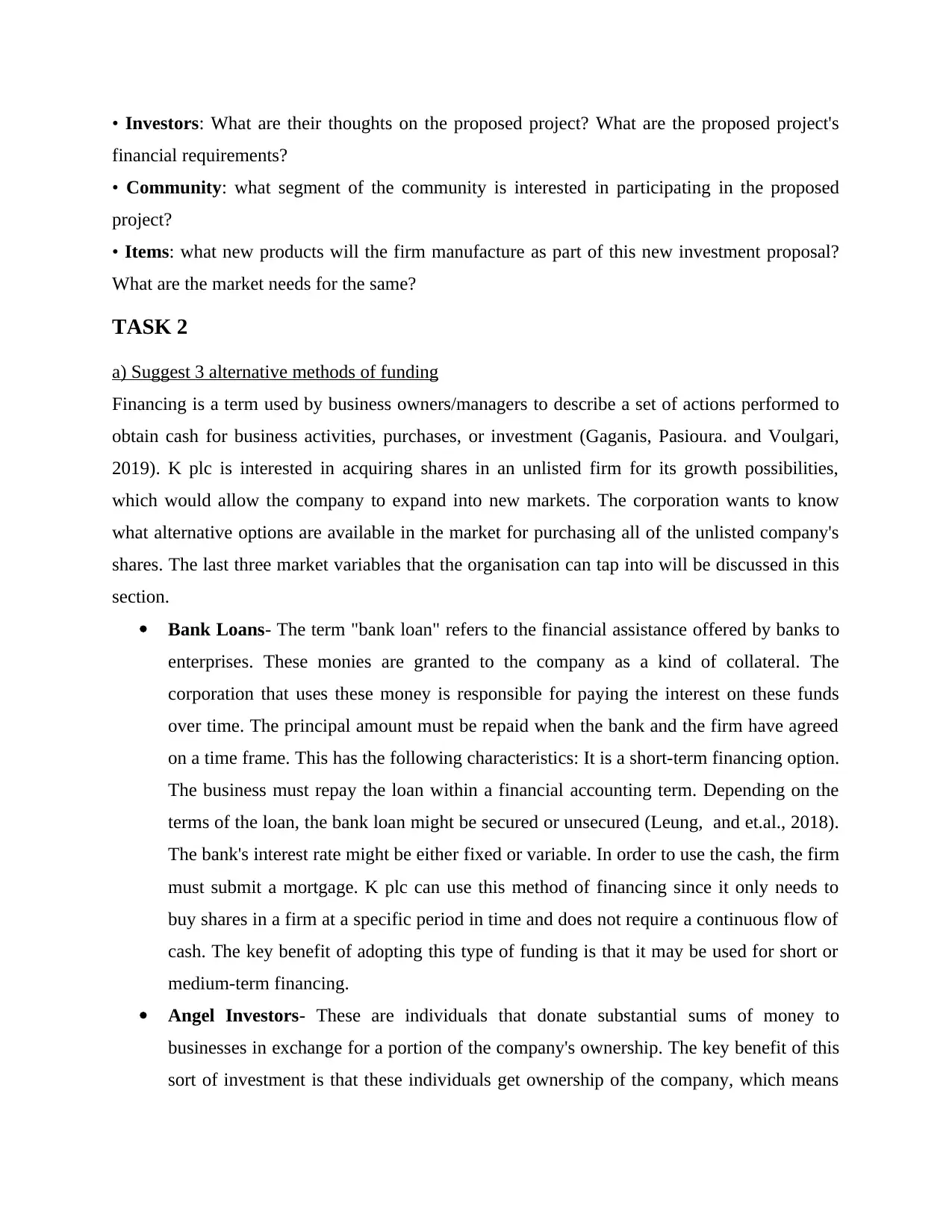
• Investors: What are their thoughts on the proposed project? What are the proposed project's
financial requirements?
• Community: what segment of the community is interested in participating in the proposed
project?
• Items: what new products will the firm manufacture as part of this new investment proposal?
What are the market needs for the same?
TASK 2
a) Suggest 3 alternative methods of funding
Financing is a term used by business owners/managers to describe a set of actions performed to
obtain cash for business activities, purchases, or investment (Gaganis, Pasioura. and Voulgari,
2019). K plc is interested in acquiring shares in an unlisted firm for its growth possibilities,
which would allow the company to expand into new markets. The corporation wants to know
what alternative options are available in the market for purchasing all of the unlisted company's
shares. The last three market variables that the organisation can tap into will be discussed in this
section.
Bank Loans- The term "bank loan" refers to the financial assistance offered by banks to
enterprises. These monies are granted to the company as a kind of collateral. The
corporation that uses these money is responsible for paying the interest on these funds
over time. The principal amount must be repaid when the bank and the firm have agreed
on a time frame. This has the following characteristics: It is a short-term financing option.
The business must repay the loan within a financial accounting term. Depending on the
terms of the loan, the bank loan might be secured or unsecured (Leung, and et.al., 2018).
The bank's interest rate might be either fixed or variable. In order to use the cash, the firm
must submit a mortgage. K plc can use this method of financing since it only needs to
buy shares in a firm at a specific period in time and does not require a continuous flow of
cash. The key benefit of adopting this type of funding is that it may be used for short or
medium-term financing.
Angel Investors- These are individuals that donate substantial sums of money to
businesses in exchange for a portion of the company's ownership. The key benefit of this
sort of investment is that these individuals get ownership of the company, which means
financial requirements?
• Community: what segment of the community is interested in participating in the proposed
project?
• Items: what new products will the firm manufacture as part of this new investment proposal?
What are the market needs for the same?
TASK 2
a) Suggest 3 alternative methods of funding
Financing is a term used by business owners/managers to describe a set of actions performed to
obtain cash for business activities, purchases, or investment (Gaganis, Pasioura. and Voulgari,
2019). K plc is interested in acquiring shares in an unlisted firm for its growth possibilities,
which would allow the company to expand into new markets. The corporation wants to know
what alternative options are available in the market for purchasing all of the unlisted company's
shares. The last three market variables that the organisation can tap into will be discussed in this
section.
Bank Loans- The term "bank loan" refers to the financial assistance offered by banks to
enterprises. These monies are granted to the company as a kind of collateral. The
corporation that uses these money is responsible for paying the interest on these funds
over time. The principal amount must be repaid when the bank and the firm have agreed
on a time frame. This has the following characteristics: It is a short-term financing option.
The business must repay the loan within a financial accounting term. Depending on the
terms of the loan, the bank loan might be secured or unsecured (Leung, and et.al., 2018).
The bank's interest rate might be either fixed or variable. In order to use the cash, the firm
must submit a mortgage. K plc can use this method of financing since it only needs to
buy shares in a firm at a specific period in time and does not require a continuous flow of
cash. The key benefit of adopting this type of funding is that it may be used for short or
medium-term financing.
Angel Investors- These are individuals that donate substantial sums of money to
businesses in exchange for a portion of the company's ownership. The key benefit of this
sort of investment is that these individuals get ownership of the company, which means
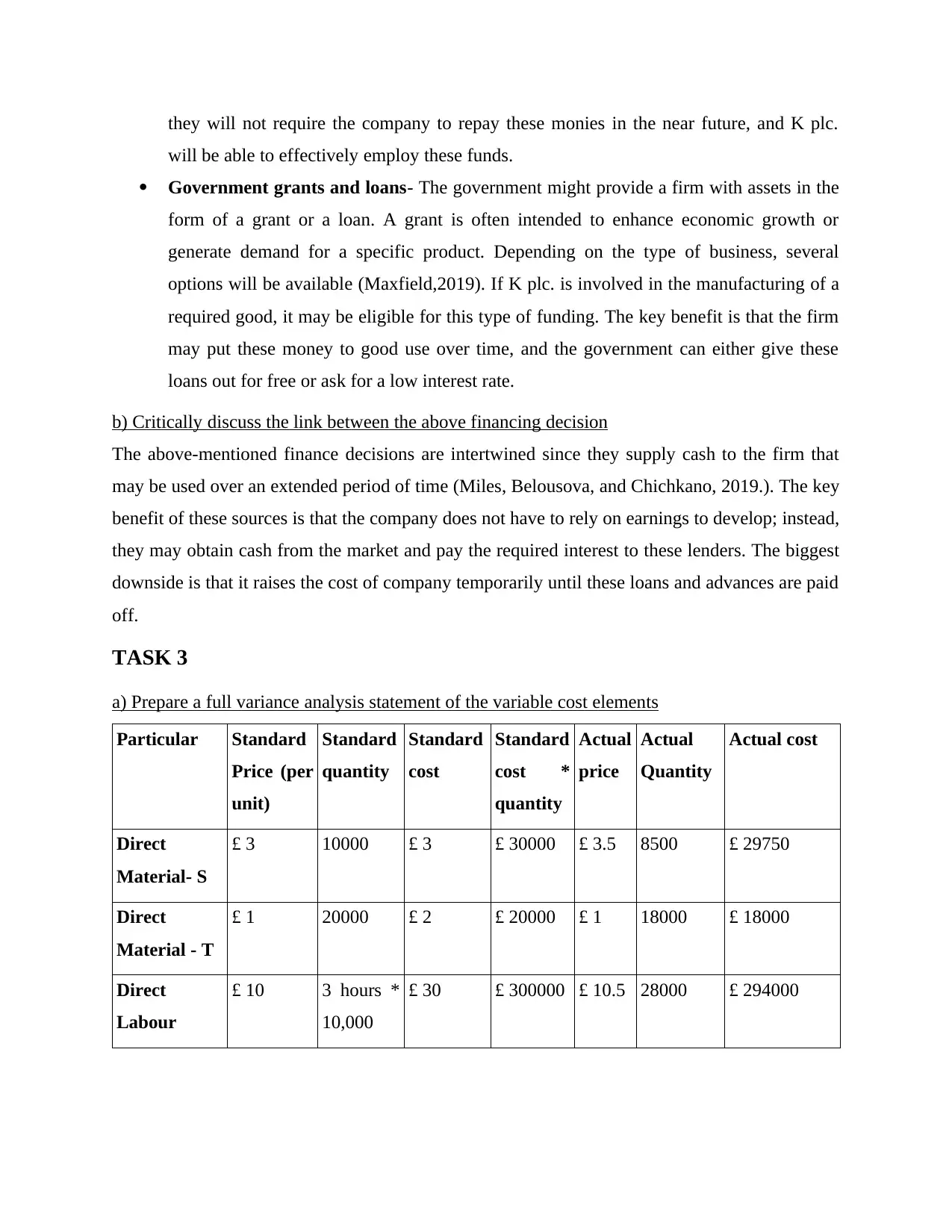
they will not require the company to repay these monies in the near future, and K plc.
will be able to effectively employ these funds.
Government grants and loans- The government might provide a firm with assets in the
form of a grant or a loan. A grant is often intended to enhance economic growth or
generate demand for a specific product. Depending on the type of business, several
options will be available (Maxfield,2019). If K plc. is involved in the manufacturing of a
required good, it may be eligible for this type of funding. The key benefit is that the firm
may put these money to good use over time, and the government can either give these
loans out for free or ask for a low interest rate.
b) Critically discuss the link between the above financing decision
The above-mentioned finance decisions are intertwined since they supply cash to the firm that
may be used over an extended period of time (Miles, Belousova, and Chichkano, 2019.). The key
benefit of these sources is that the company does not have to rely on earnings to develop; instead,
they may obtain cash from the market and pay the required interest to these lenders. The biggest
downside is that it raises the cost of company temporarily until these loans and advances are paid
off.
TASK 3
a) Prepare a full variance analysis statement of the variable cost elements
Particular Standard
Price (per
unit)
Standard
quantity
Standard
cost
Standard
cost *
quantity
Actual
price
Actual
Quantity
Actual cost
Direct
Material- S
£ 3 10000 £ 3 £ 30000 £ 3.5 8500 £ 29750
Direct
Material - T
£ 1 20000 £ 2 £ 20000 £ 1 18000 £ 18000
Direct
Labour
£ 10 3 hours *
10,000
£ 30 £ 300000 £ 10.5 28000 £ 294000
will be able to effectively employ these funds.
Government grants and loans- The government might provide a firm with assets in the
form of a grant or a loan. A grant is often intended to enhance economic growth or
generate demand for a specific product. Depending on the type of business, several
options will be available (Maxfield,2019). If K plc. is involved in the manufacturing of a
required good, it may be eligible for this type of funding. The key benefit is that the firm
may put these money to good use over time, and the government can either give these
loans out for free or ask for a low interest rate.
b) Critically discuss the link between the above financing decision
The above-mentioned finance decisions are intertwined since they supply cash to the firm that
may be used over an extended period of time (Miles, Belousova, and Chichkano, 2019.). The key
benefit of these sources is that the company does not have to rely on earnings to develop; instead,
they may obtain cash from the market and pay the required interest to these lenders. The biggest
downside is that it raises the cost of company temporarily until these loans and advances are paid
off.
TASK 3
a) Prepare a full variance analysis statement of the variable cost elements
Particular Standard
Price (per
unit)
Standard
quantity
Standard
cost
Standard
cost *
quantity
Actual
price
Actual
Quantity
Actual cost
Direct
Material- S
£ 3 10000 £ 3 £ 30000 £ 3.5 8500 £ 29750
Direct
Material - T
£ 1 20000 £ 2 £ 20000 £ 1 18000 £ 18000
Direct
Labour
£ 10 3 hours *
10,000
£ 30 £ 300000 £ 10.5 28000 £ 294000
⊘ This is a preview!⊘
Do you want full access?
Subscribe today to unlock all pages.

Trusted by 1+ million students worldwide
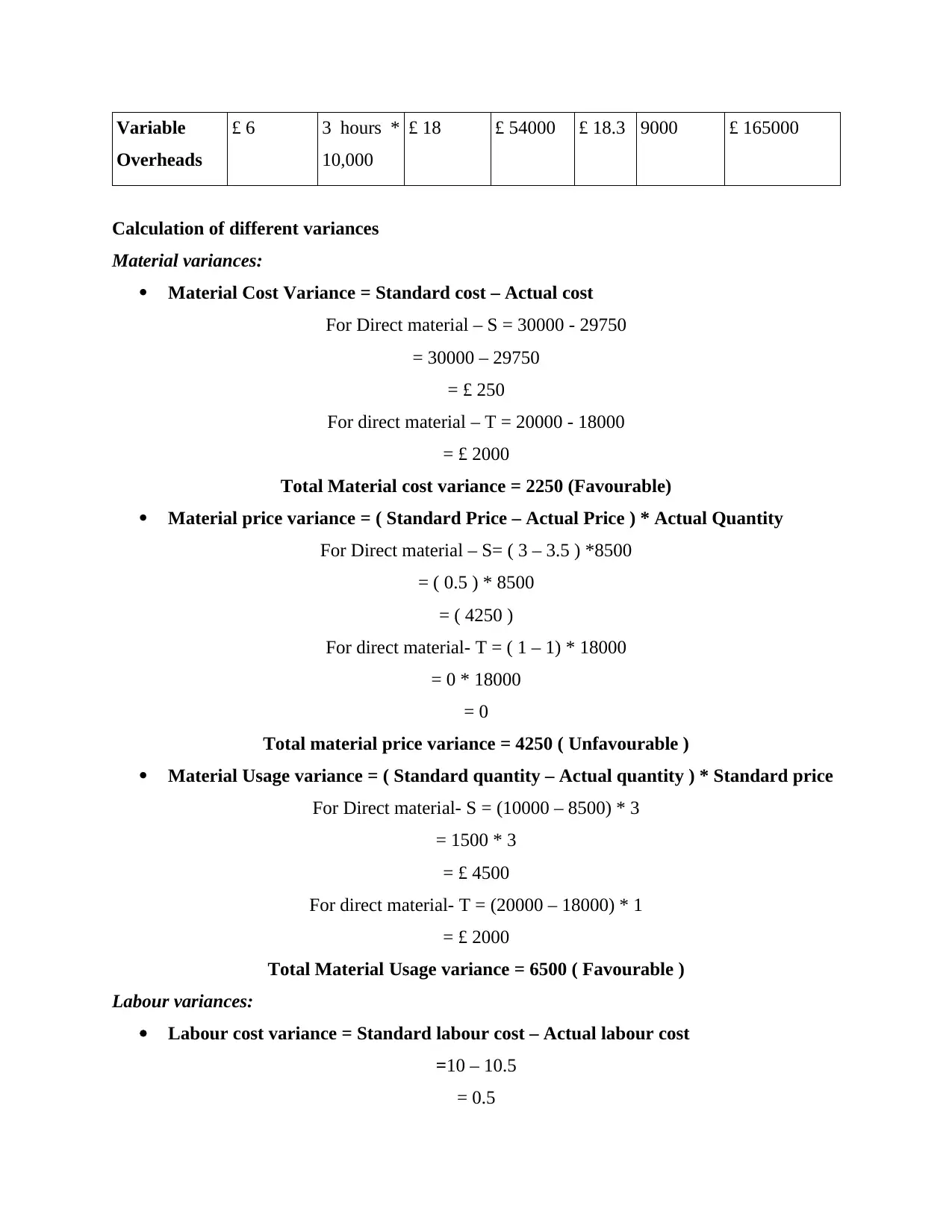
Variable
Overheads
£ 6 3 hours *
10,000
£ 18 £ 54000 £ 18.3 9000 £ 165000
Calculation of different variances
Material variances:
Material Cost Variance = Standard cost – Actual cost
For Direct material – S = 30000 - 29750
= 30000 – 29750
= £ 250
For direct material – T = 20000 - 18000
= £ 2000
Total Material cost variance = 2250 (Favourable)
Material price variance = ( Standard Price – Actual Price ) * Actual Quantity
For Direct material – S= ( 3 – 3.5 ) *8500
= ( 0.5 ) * 8500
= ( 4250 )
For direct material- T = ( 1 – 1) * 18000
= 0 * 18000
= 0
Total material price variance = 4250 ( Unfavourable )
Material Usage variance = ( Standard quantity – Actual quantity ) * Standard price
For Direct material- S = (10000 – 8500) * 3
= 1500 * 3
= £ 4500
For direct material- T = (20000 – 18000) * 1
= £ 2000
Total Material Usage variance = 6500 ( Favourable )
Labour variances:
Labour cost variance = Standard labour cost – Actual labour cost
=10 – 10.5
= 0.5
Overheads
£ 6 3 hours *
10,000
£ 18 £ 54000 £ 18.3 9000 £ 165000
Calculation of different variances
Material variances:
Material Cost Variance = Standard cost – Actual cost
For Direct material – S = 30000 - 29750
= 30000 – 29750
= £ 250
For direct material – T = 20000 - 18000
= £ 2000
Total Material cost variance = 2250 (Favourable)
Material price variance = ( Standard Price – Actual Price ) * Actual Quantity
For Direct material – S= ( 3 – 3.5 ) *8500
= ( 0.5 ) * 8500
= ( 4250 )
For direct material- T = ( 1 – 1) * 18000
= 0 * 18000
= 0
Total material price variance = 4250 ( Unfavourable )
Material Usage variance = ( Standard quantity – Actual quantity ) * Standard price
For Direct material- S = (10000 – 8500) * 3
= 1500 * 3
= £ 4500
For direct material- T = (20000 – 18000) * 1
= £ 2000
Total Material Usage variance = 6500 ( Favourable )
Labour variances:
Labour cost variance = Standard labour cost – Actual labour cost
=10 – 10.5
= 0.5
Paraphrase This Document
Need a fresh take? Get an instant paraphrase of this document with our AI Paraphraser
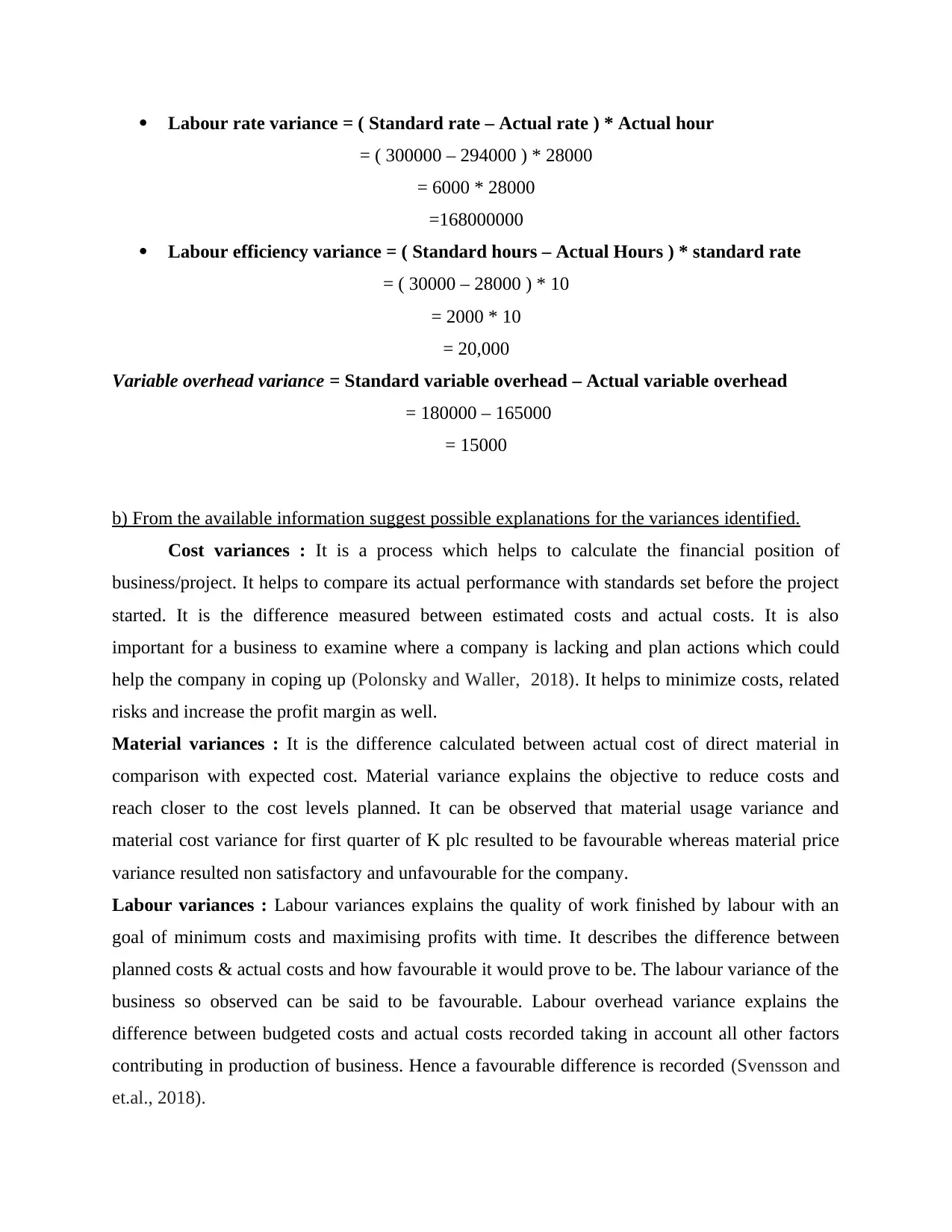
Labour rate variance = ( Standard rate – Actual rate ) * Actual hour
= ( 300000 – 294000 ) * 28000
= 6000 * 28000
=168000000
Labour efficiency variance = ( Standard hours – Actual Hours ) * standard rate
= ( 30000 – 28000 ) * 10
= 2000 * 10
= 20,000
Variable overhead variance = Standard variable overhead – Actual variable overhead
= 180000 – 165000
= 15000
b) From the available information suggest possible explanations for the variances identified.
Cost variances : It is a process which helps to calculate the financial position of
business/project. It helps to compare its actual performance with standards set before the project
started. It is the difference measured between estimated costs and actual costs. It is also
important for a business to examine where a company is lacking and plan actions which could
help the company in coping up (Polonsky and Waller, 2018). It helps to minimize costs, related
risks and increase the profit margin as well.
Material variances : It is the difference calculated between actual cost of direct material in
comparison with expected cost. Material variance explains the objective to reduce costs and
reach closer to the cost levels planned. It can be observed that material usage variance and
material cost variance for first quarter of K plc resulted to be favourable whereas material price
variance resulted non satisfactory and unfavourable for the company.
Labour variances : Labour variances explains the quality of work finished by labour with an
goal of minimum costs and maximising profits with time. It describes the difference between
planned costs & actual costs and how favourable it would prove to be. The labour variance of the
business so observed can be said to be favourable. Labour overhead variance explains the
difference between budgeted costs and actual costs recorded taking in account all other factors
contributing in production of business. Hence a favourable difference is recorded (Svensson and
et.al., 2018).
= ( 300000 – 294000 ) * 28000
= 6000 * 28000
=168000000
Labour efficiency variance = ( Standard hours – Actual Hours ) * standard rate
= ( 30000 – 28000 ) * 10
= 2000 * 10
= 20,000
Variable overhead variance = Standard variable overhead – Actual variable overhead
= 180000 – 165000
= 15000
b) From the available information suggest possible explanations for the variances identified.
Cost variances : It is a process which helps to calculate the financial position of
business/project. It helps to compare its actual performance with standards set before the project
started. It is the difference measured between estimated costs and actual costs. It is also
important for a business to examine where a company is lacking and plan actions which could
help the company in coping up (Polonsky and Waller, 2018). It helps to minimize costs, related
risks and increase the profit margin as well.
Material variances : It is the difference calculated between actual cost of direct material in
comparison with expected cost. Material variance explains the objective to reduce costs and
reach closer to the cost levels planned. It can be observed that material usage variance and
material cost variance for first quarter of K plc resulted to be favourable whereas material price
variance resulted non satisfactory and unfavourable for the company.
Labour variances : Labour variances explains the quality of work finished by labour with an
goal of minimum costs and maximising profits with time. It describes the difference between
planned costs & actual costs and how favourable it would prove to be. The labour variance of the
business so observed can be said to be favourable. Labour overhead variance explains the
difference between budgeted costs and actual costs recorded taking in account all other factors
contributing in production of business. Hence a favourable difference is recorded (Svensson and
et.al., 2018).
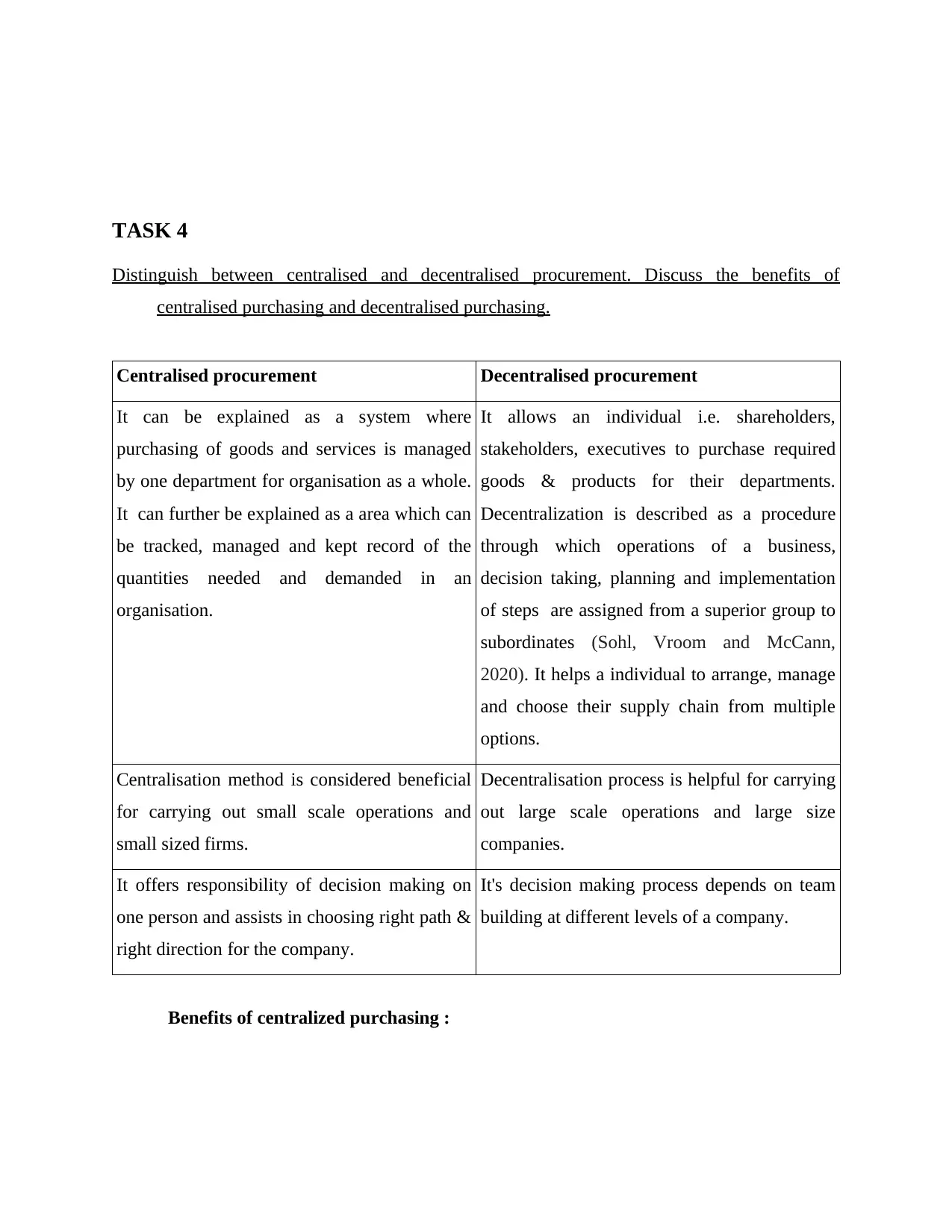
TASK 4
Distinguish between centralised and decentralised procurement. Discuss the benefits of
centralised purchasing and decentralised purchasing.
Centralised procurement Decentralised procurement
It can be explained as a system where
purchasing of goods and services is managed
by one department for organisation as a whole.
It can further be explained as a area which can
be tracked, managed and kept record of the
quantities needed and demanded in an
organisation.
It allows an individual i.e. shareholders,
stakeholders, executives to purchase required
goods & products for their departments.
Decentralization is described as a procedure
through which operations of a business,
decision taking, planning and implementation
of steps are assigned from a superior group to
subordinates (Sohl, Vroom and McCann,
2020). It helps a individual to arrange, manage
and choose their supply chain from multiple
options.
Centralisation method is considered beneficial
for carrying out small scale operations and
small sized firms.
Decentralisation process is helpful for carrying
out large scale operations and large size
companies.
It offers responsibility of decision making on
one person and assists in choosing right path &
right direction for the company.
It's decision making process depends on team
building at different levels of a company.
Benefits of centralized purchasing :
Distinguish between centralised and decentralised procurement. Discuss the benefits of
centralised purchasing and decentralised purchasing.
Centralised procurement Decentralised procurement
It can be explained as a system where
purchasing of goods and services is managed
by one department for organisation as a whole.
It can further be explained as a area which can
be tracked, managed and kept record of the
quantities needed and demanded in an
organisation.
It allows an individual i.e. shareholders,
stakeholders, executives to purchase required
goods & products for their departments.
Decentralization is described as a procedure
through which operations of a business,
decision taking, planning and implementation
of steps are assigned from a superior group to
subordinates (Sohl, Vroom and McCann,
2020). It helps a individual to arrange, manage
and choose their supply chain from multiple
options.
Centralisation method is considered beneficial
for carrying out small scale operations and
small sized firms.
Decentralisation process is helpful for carrying
out large scale operations and large size
companies.
It offers responsibility of decision making on
one person and assists in choosing right path &
right direction for the company.
It's decision making process depends on team
building at different levels of a company.
Benefits of centralized purchasing :
⊘ This is a preview!⊘
Do you want full access?
Subscribe today to unlock all pages.

Trusted by 1+ million students worldwide
1 out of 15
Related Documents
Your All-in-One AI-Powered Toolkit for Academic Success.
+13062052269
info@desklib.com
Available 24*7 on WhatsApp / Email
![[object Object]](/_next/static/media/star-bottom.7253800d.svg)
Unlock your academic potential
Copyright © 2020–2025 A2Z Services. All Rights Reserved. Developed and managed by ZUCOL.





